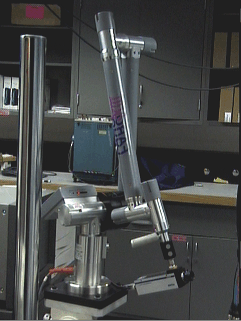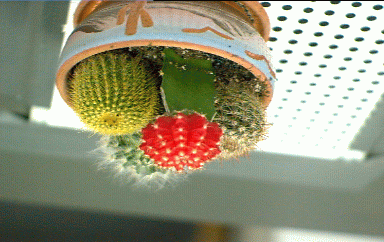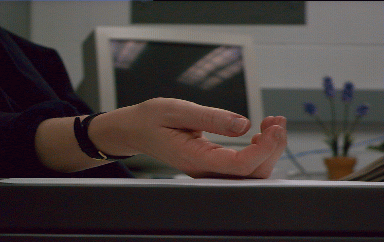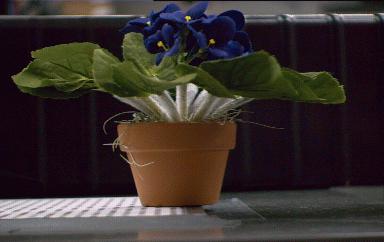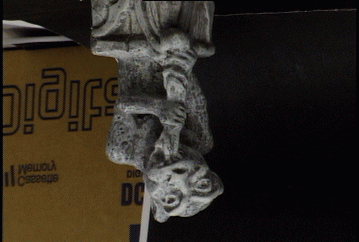Acquisition Process
Sequences "cactus," "hand," and "violet:"
The first three sequences were acquired with a 3CCD VX-1000 Sony Camcorder that was mounted on the end-effector of a Faro Technologies 6-foot Silver FaroArm. The FaroArm provides frame-synchronized information about the end-effector's 3D position and orientation within a spherical workspace. The workspace diameter was approximately 6 feet:
To capture each sequence, the FaroArm's end-effector (and the camera attached to it) were moved manually to various locations inside that workspace and around the scene of interest.
Before acquiring each sequence, the camera and FaroArm were jointly calibrated in order to compute the camera's internal calibration parameters as well as the rigid transformation between the coordinate systems of the camera and the FaroArm's end-effector. The calibration was performed using the Vista implementation of Tsai's calibration algorithm. This made it possible to convert the frame-synchronized 3D position and orientation of the end-effector into extrinsic calibration parameters for each frame.
All images were acquired with standard room illumination (ie. the laboratory's overhead fluorescent lighting). Illumination was static during image acquisition although some faint shadows may be present in some of the frames due to partial occlusion of the overhead lighting by the FaroArm. This was unavoidable given the very wide range of the input viewpoints.
All sequences were acquired at the University of Rochester by Kyros Kutulakos.
Sequence "gargoyle":
Images were acquired by rotating the gargoyle by a known amount in front of a calibrated 3CCD VX-1000 Sony Camcorder. Calibration was performed using the Vista implementation of Tsai's calibration algorithm.
To eliminate cast shadows, all images were acquired using illumination from a halogen lamp that was positioned close to the camcorder. As a result, unlike the above three sequences, the relation between the object and the light sources changed during image acquisition.
Note that the background behind the gargoyle was manually changed after each image was acquired. This ensured that photo-consistent 3D shapes can only project to pixels inside the garoyle's projection in each view.
This sequence acquired at the University of Rochester by Kyros Kutulakos.
References
- Rahul Bhotika, David J. Fleet and Kiriakos N. Kutulakos, "A Probabilistic Theory of Occupancy and Emptiness," Proc. 7th European Conf. on Computer Vision, pp. 112-130, 2002.
- Kiriakos N. Kutulakos, "Approximate N-View Stereo," Proc. 6th European Conf. on Computer Vision, pp.60-67, 2000.
- Kiriakos N. Kutulakos and Steven M. Seitz, "A Theory of Shape by Space Carving," Int. J. Computer Vision, vol. 38, no. 3, pp. 197-216, 2000.
- Kiriakos N. Kutulakos and Steven M. Seitz, "A Theory of Shape by Space Carving," Proc. 7th Int. Conf. on Computer Vision, pp. 307-314, 1999.
SEQUENCE #1: CACTUS
Scene Data
[Note1: All X,Y,Z world coordinates are in mm]
[Note2: Bounding box information is approximate, i.e., some scene points may lie outside the box]
Approximate Scene Bounding Box # Images Calibration Accuracy Box center:
Box: Dimensions:[0,30,70]
[100,100,100]30 Re-projection errors are approximately 1-3 pixels Image Data
[Note1: MPEG links point to low-resolution previews of the full-resolution TIFF image sequences]
[Note2: Camera calibration parameters are in the Vista VCamera format. For an explanation of these parameters, see this page.]
First Frame Image
Sequences
Calibration Parameters TIFF cactus2-calb.tar.gz
SEQUENCE #2: HAND
Scene Data
[Note1: All X,Y,Z world coordinates are in mm]
[Note2: Bounding box information is approximate, i.e., some scene points may lie outside the box]
Approximate Scene Bounding Box # Images Calibration Accuracy Box center:
Box: Dimensions:[60,110,70]
[140,140,140]99 Re-projection errors are approximately 0.5-1 pixels Image Data
[Note1: MPEG links point to low-resolution previews of the full-resolution TIFF image sequences]
[Note2: Camera calibration parameters are in the Vista VCamera format. For an explanation of these parameters, see this page.]
First Frame Image
Sequences
Calibration Parameters TIFF sarah-last-calb.tar.gz
SEQUENCE #3: VIOLET
Scene Data
[Note1: All X,Y,Z world coordinates are in mm]
[Note2: Bounding box information is approximate, i.e., some scene points may lie outside the box]
Approximate Scene Bounding Box # Images Calibration Accuracy Box center:
Box: Dimensions:[-30,160,70]
[260,260,260]40 Re-projection errors are approximately 0.5-1 pixels Image Data
[Note1: MPEG links point to low-resolution previews of the full-resolution TIFF image sequences]
[Note2: Camera calibration parameters are in the Vista VCamera format. For an explanation of these parameters, see this page.]
First Frame Image
Sequences
Calibration Parameters TIFF violet-calb.tar.gz
SEQUENCE #4: GARGOYLE
Scene Data
[Note1: All X,Y,Z world coordinates are in mm]
[Note2: Bounding box information is approximate, i.e., some scene points may lie outside the box]
Approximate Scene Bounding Box # Images Calibration Accuracy Box center:
Box: Dimensions:[20,-50,20]
[140,140,140]16 Re-projection errors are approximately 0.5 pixels Image Data
[Note1: MPEG links point to low-resolution previews of the full-resolution TIFF image sequences]
[Note2: The MPEG sequence is flipped vertically for visualizatoin purposes
[Note2: Camera calibration parameters are in the Vista VCamera format. For an explanation of these parameters, see this page.]
First Frame Image
Sequences
Calibration Parameters TIFF gargoyle-calb.tar.gz
